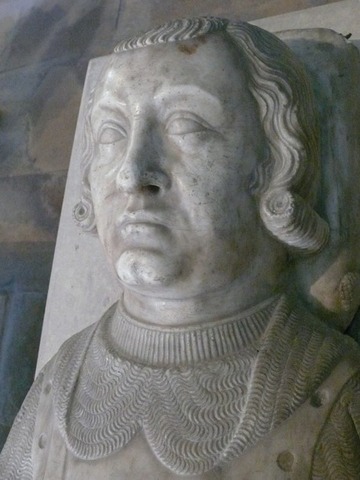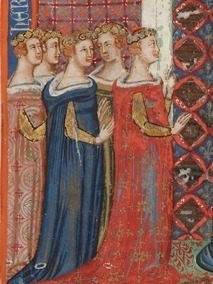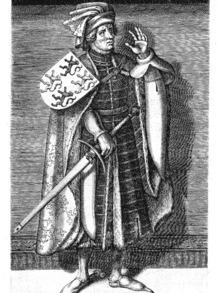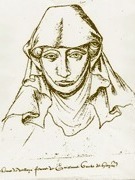Familienstammbaum Snelder - Versteegh » Empress Beatrix of Glogau (1311-1356)
Persönliche Daten Empress Beatrix of Glogau
Quelle 1- Sie ist geboren im Jahr 1311 in Of, Le Quesnoy, Nord, France.
 Pass auf: Verheiratet (??-??-1308) vor Geburt (??-??-1311).
Pass auf: Verheiratet (??-??-1308) vor Geburt (??-??-1311). Pass auf: Alter bei der Heirat (??-??-1308) war unter 16 Jahre (0).
Pass auf: Alter bei der Heirat (??-??-1308) war unter 16 Jahre (0). - Sie ist verstorben am 23. Juni 1356 in Le Quesnoy, sie war 45 Jahre alt.
- Ein Kind von William I of Hainaut und Joan of Valois
Familie von Empress Beatrix of Glogau
Sie ist verheiratet mit Louis IV of Bavaria.
Sie haben geheiratet im Jahr 1308.
Kind(er):
Notizen bei Empress Beatrix of Glogau
https://en.wikipedia.org/wiki/Margaret_II,_Countess_of_Hainaut
Margaret II of Avesnes (1311 – 23 June 1356) was Countess of Hainaut and Countess of Holland (as Margaret I) from 1345 to 1356. She was Holy Roman Empress and Queen of Germany by marriage to Emperor Louis IV the Bavarian.
Margaret was the daughter of William I, Count of Hainaut, and Joan of Valois. She spent her childhood in Henegouwen and also frequently visited France with her French mother.[1]
On 26 February 1324 in Cologne she married Louis IV, thereby becoming queen of Germany. On 17 January 1328, she was crowned empress alongside her spouse in Rome.
She succeeded in 1345 her brother William II of Hainaut (William IV) following his death in battle with later Louis IV the Bavarian designating that Hainaut, Holland, Zeelandand Friesland were his wife's possessions.[2] Louis gave his support to Margaret because he was reportedly worried that the domains of her late brother would otherwise be lost to the empire.[3] Due to the dangerous hostility of the House of Luxemburg Louis increased his power base ruthlessly.
Margaret traveled to Henegouwen and was recognized there in her new position as ruler, and on 26 March, she left Henegouwen to visit her Northern domains of Holland and Zeeland. There where different difficulty in securing the position of Margaret in her three domains. In Holland and Zeeland, there were doubts as to whether female succession was legal, and while her gender was not a problem in Hainaut, there where still the question of her sister's claims upon the domain.[4] Margaret granted the cities and citizens in Holland and Zeeland several economic privileges to secure her position.[5] The claims of her sisters were also addressed.
A parchment dated 7 September 1346 in Frankfurt, of which the seal is destroyed, announces that Louis IV of Bavaria, Emperor of the Holy Germanic Empire bestows for himself and his heirs, in the name of his spouse, the empress Margaret, to never cede, divide or bestow the counties of Hainut, Holland, Zeeland and the palatine of Frisia, which belong to his wife, Margaret II (of Avesnes), Countess of Hainaut and to her heirs, excepting the rights of her sisters and after her death, to William (future William III, Count of Hainaut) Duke (I) of Bavaria, and after his decease to Albert (future Albert I, Count of Hainaut) [6] and later these passed to their son William V. Margaret's sisters, including Philippa of Hainaut who was Queen consort of Edward III of England disavowed their hereditary claims.[7]
Margaret ruled her three domains directly for seven months, after which she was called back to Germany by her spouse, and appointed her second son William to rule in her absence.[8][9]
When Louis IV died on 11 October 1347, he was succeeded by his six sons, and in connection to this, Margaret resigned her sovereignty in favor of her son William in exchange for an allowance.[10] In 1349 the brothers decided to partition their possessions; Louis V, Duke of Bavaria kept Brandenburg and Tyrol, he and his younger brothers Louis VI the Roman and Otto V the Bavarian received ;Upper Bavaria. Stephen II, William and Albert received Lower Bavaria, Holland and Hainaut. Louis V and Stephen were not sons of Margaret, and her youngest sons Albert and Otto were still minors. Louis VI released Holland and Hainaut for his brothers William and Albert in 1349 since he expected the Polish crown by his marriage with Cunigunde of Poland. In 1353 also Stephen released Holland and Hainaut to his brother William.
However, a conflict soon aroused between Margaret and her son William, as he refused to honor the terms in her abdication document by withholding the allowance she had demanded in turn for abdicating in his favor.[11] Willem's opposition among the nobles of Holland asked Margaret to return to run Holland again, and in March 1350, Margaret had returned to Henegouwen, where she retracted her abdication in 1 June.[12] The Cod League was formed on 23 May 1350 by a number of supporters of William, and on 5 September of the same year, the Hook League was formed in support of Margaret.[13] Soon afterward these factions clashed and a civil war began, known as the Hook and Cod wars.
Margaret and the war between mother and son was controversial, and her right to Holland was always considered to be of dubious legality, as this domain was at that time regarded as reserved for men, though the same thing was not raised when it came to her right to Hainaut.[14]
After the destruction of several strongholds of Margaret and a defeat of her forces at two sea battles in 1351, Edward III of England, Margaret's brother-in-law through her sister Philippa of Hainault, came to her aid, winning a naval engagement off Veere in 1351; a few weeks later the Hooks and their English allies were defeated by William and the Cods at Vlaardingen, a defeat which ruined Margaret's cause. Edward III shortly afterwards changed sides and in 1354, Margaret saw herself compelled to come to an understanding with her son: he being recognized as count of Holland and Zeeland, and she being secured as ruling countess of Hainaut in her lifetime.[15]
Margaret ruled Hainaut for two more years, and died at Le Quesnoy Castle of infectious tuberculosis 23 June 1356, leaving William in possession of the entire Holland-Hainaut inheritance. She was buried in the Minderbroeders Abbey in Valenciennes.
In 1324 she married Louis IV, Holy Roman Emperor. Their children were:
- Margaret (1325–1374), married:
- in 1351 in Buda Stephen, Duke of Slavonia (d. 1354), son of the King Charles I of Hungary, and had issue;
- 1357/58 Gerlach von Hohenlohe.
- Anna (c. 1326 – 3 June 1361, Fontenelles) married John I of Lower Bavaria (d. 1340)
- Louis VI the Roman (1328–1365), duke of Upper Bavaria, elector of Brandenburg. No issue.
- Elisabeth (1329 – 2 August 1402, Stuttgart), married:
- Cangrande II della Scala, Lord of Verona (d. 1359) in Verona on 22 November 1350. No issue
- Count Ulrich of ;Württemberg (d. 1388) in 1362. No issue
- William V of Holland (1330–1389), as William I duke of Lower Bavaria, as Wiliam V count of Hainaut and Holland. He married Maud of Lancaster but their only daughter died young
- Agnes (Munich, 1335 – 11 November 1352, Munich). She became a nun, due to ill health and died young
- Albert I of Holland (1336–1404), duke of Lower Bavaria, count of Hainaut and Holland
- Otto V the Bavarian (1340–1379), duke of Upper Bavaria, elector of Brandenburg
- Beatrice of Bavaria (1344 – 25 December 1359), married bef. 25 October 1356 Eric XII of Sweden
- Louis (October 1347 – 1348)
Zeitbalken Empress Beatrix of Glogau
 Großeltern
Großeltern
 Eltern
Eltern
 Geschwister
Geschwister
 Kinder
Kinder
Vorfahren (und Nachkommen) von Beatrix of Glogau
Beatrix of Glogau 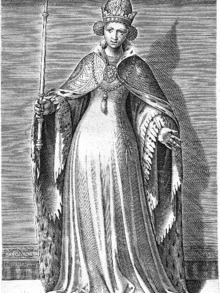 | ||||||||||||||||||||||||||||||||||
1308 | ||||||||||||||||||||||||||||||||||
Louis IV of Bavaria | ||||||||||||||||||||||||||||||||||
Verwandschaft Empress Beatrix of Glogau
- Beatrix of Glogau ist die Ur(x53)enkeltochter von Titus Manlius Imperiosus Torquatus:Titus Manlius Imperiosus TorquatusTitus Manlius TorquatusTitus Manlius TorquatusAulus Manlius TorquatusTitus Manlius TorquatusDecimus Junius Silanus ManlianusMarcus Junius Silanus consulMarcus Junius SilanusMarcus Junius Silanus consulMarcus Junius SilanusJunia Calvina EquitusGaius SallustiusGaius Ummidius Quadratus SallustiusGaius Ummidius Quadratus Annianus VerusGaius Ummidius Quadratus Annianus Verus FulviusUmmidia Commificia AntoniaPendania Pedanius FuscusMariana MinorAurelia PompeianaClaudiaConstantius I Chlorus of RomeUnkownProcopius UsurperProcopiusProcopius II Magister Militum of ByzantiumProcopius Anthemius I of the of the Western Roman EmpireAlypia Princess of the of RomeCaratene Agrippina of NarbonneClothilde of BurgundyChlothar I of the FranksCharibert I of ParisBilichildeArnoald of MetzDodaAnsegisel of the FranksPepin II of HerstalCharles Martel of the FranksPepin The Short III of the FranksCharlemange (Charles I) of the FranksLouis I the Pious de Aquitaine of FranceCharles the BaldLouis the Stammerer of FranceKing Charles III the SimpleLouis IV of France (Carolingian)Charles of LorraineErmengarde of LorraineAlbert II of NamurAlbert III of NamurHenry I of RocheMathilda of RocheJames of AvesnesBouchard of AvesnesJohn I of HainautJohn II of HainautWilliam I of HainautBeatrix of Glogau
Quellen
- Snelder-Versteegh Web Site, roel snelder, via https://www.myheritage.nl/person-2000135...
Persoon toegevoegd door het bevestigen van een Smart Match
Stambomen op MyHeritage
Familiesite: Snelder-Versteegh Web Site
Familiestamboom: 388366452-1
Historische Ereignisse
Sterbedatum 23. Juni 1356
- Graaf Willem V (Beiers Huis) war von 1349 bis 1389 Fürst der Niederlande (auch Graafschap Holland genannt)
Gleicher Geburts-/Todestag
- 1290 » Heinrich der Gerechte, Herzog in Schlesien-Breslau
- 1318 » Gilles Aycelin de Montaigut, Erzbischof von Narbonne und Rouen
- 1324 » Aymer de Valence, 2. Earl of Pembroke, englischer Magnat
- 1349 » Pierre Bertrand, französischer Kardinal, Theologe und Kirchenrechtler
- 1356 » Margarethe von Holland, römisch-deutsche Königin und Kaiserin
- 1371 » Johann von Virneburg, gewählter, aber nicht päpstlich anerkannter Erzbischof von Köln, Bischof von Münster und danach Bischof von Utrecht
Über den Familiennamen Of Glogau
- Zeigen Sie die Informationen an, über die Genealogie Online verfügt über den Nachnamen Of Glogau.
- Überprüfen Sie die Informationen, die Open Archives hat über Of Glogau.
- Überprüfen Sie im Register Wie (onder)zoekt wie?, wer den Familiennamen Of Glogau (unter)sucht.
Roel Snelder, "Familienstammbaum Snelder - Versteegh", Datenbank, Genealogie Online (https://www.genealogieonline.nl/stamboom-snelder-versteegh/I506804.php : abgerufen 5. Juni 2024), "Empress Beatrix of Glogau (1311-1356)".

